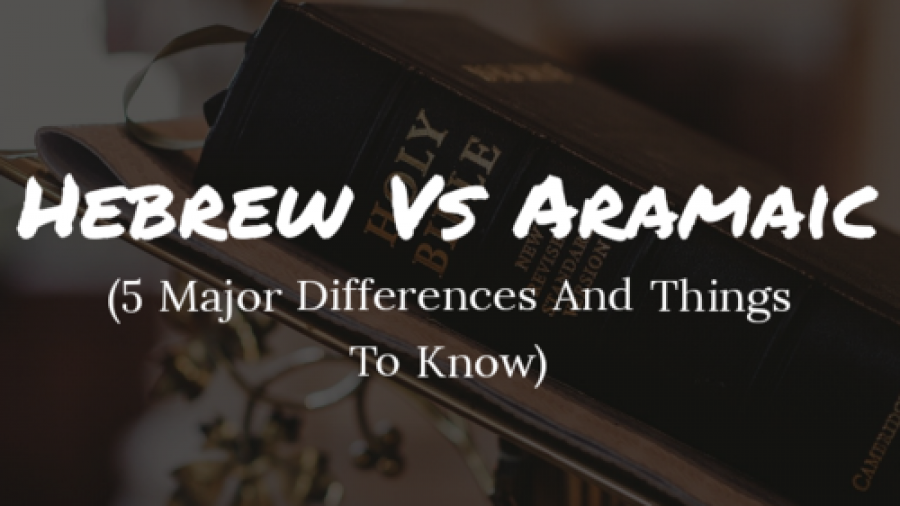Hebrew and Aramaic are sister languages from ancient times, and both are still spoken today! Modern Hebrew is the official language of the nation of Israel and is also spoken by about 220,000 Jewish Americans. Biblical Hebrew is used for prayer and scripture reading in Jewish communities around the world. Aramaic is still spoken by Jewish Kurds and other small groups living in Iran, Iraq, Syria, and Turkey.
Both Aramaic and Hebrew (mostly Hebrew) were used in the Old and New Testaments, and they are the only two Northwest Semitic languages still spoken today. Let’s explore the history of these two languages, compare their similarities and differences, and discover their contribution to the Bible.
History of Hebrew and Aramaic
Hebrew is a Semitic language used by the Israelites and Judeans in Old Testament times. It is the only language from the land of Canaan that is still spoken today. Hebrew is also the only dead language that was successfully revived and spoken by millions today. In the Bible, the word Hebrew was not used for the language, but rather Yehudit (the language of Judah) or səpaṯ Kəna’an (the language of Canaan).
Hebrew was the spoken language of the nations of Israel and Judah from around 1446 to 586 BC, and likely extends back to the period of Abraham hundreds of years earlier. The Hebrew used in the Bible is known as Classical Hebrew or Biblical Hebrew.
Two passages of the Old Testament (the Song of Moses in Exodus 15, and the Song of Deborah in Judges in Judges 5) were written in what is called Archaic Biblical Hebrew, which is still part of Classical Hebrew, but different is a similar way that the English used in the King James Bible is different from how we speak and write today.
During the Babylonian Empire, the Imperial Aramaic script, which looks a little like Arabic, was adopted, and modern Hebrew script descended from this writing system (very similar to Aramaic). Also, during the exile period, Hebrew began to give way to Aramaic as the spoken language of the Jews.
Mishnaic Hebrewwas used after the destruction of the Temple in Jerusalem and for the next couple of centuries. The Dead Sea Scrollsare in Mishnaic Hebrew as well as most of the Mishnah and Tosefta (Jewish oral tradition and law) in the Talmud.
Sometime between AD 200 to 400, Hebrew died out as a spoken language, after the Third Jewish-Roman War. By this time, Aramaic and Greek were spoken in Israel and by the Jewish diaspora. Hebrew did continue to be used in Jewish synagogues for the liturgy, in writings of Jewish rabbis, in poetry, and in commerce between Jews, somewhat like the Latin language persevered, although not as a spoken language.
As the Zionist movement of the 19th century pushed for an Israeli homeland, the Hebrew language was revived as a spoken and written language, spoken by the Jews who returned to their ancestral homeland. Today, Modern Hebrew is spoken by over nine million people worldwide.
Aramaic is also an ancient language over 3800 years old. In the Bible, ancient Aram was part of Syria. The Aramaic language has its origins in the Aramean city-states of Damascus, Hamath and Arpad. The alphabet at that time was similar to the Phoenician alphabet. As the country of Syria emerged, the Aramean states made it their official language.
In Genesis 31, Jacob was making a covenant with his father-in-law Laban. Genesis 31:47 reads, “Laban called it Jegar-sahadutha, and Jacob called it Galeed.” It’s giving the Aramaic name and the Hebrew name for the same place. This indicates that the patriarchs (Abraham, Isaac, Jacob) were speaking what we now call Hebrew (the language of Canaan) while Laban, who lived in Haran, was speaking Aramaic (or Syrian). Obviously, Jacob was bilingual.
After the Assyrian Empire conquered the lands west of the Euphrates River, Tiglath-Pileser II (King of Assyria from 967 to 935 BC) made Aramaic the second official language of the Empire, with the Akkadian language the first. Later Darius I (King of the Achaemenid Empire, from 522 to 486 BC) adopted it as the primary language, over Akkadian. Consequently, use of Aramaic covered vast areas, eventually splitting into an eastern and western dialect and multiple minor dialects. Aramaic is really a language-family, with variations that may be unintelligible to other Aramaic speakers.
When the Achaemenid Empire fell to Alexander the Great in 330 B.C., everyone had to begin using the Greek language; however, most people continued speaking Aramaic as well.
Many important Jewish texts were written in Aramaic, including the Talmud and Zohar, and it was used in ritual recitations like the Kaddish. Aramaic was used in yeshivot (traditional Jewish schools) as a language of Talmudic debate. Jewish communities usually used the western dialect of Aramaic. This was used in the Book of Enoch (170 BC) and in The Jewish War by Josephus.
When Islamist Arabs began conquering most of the Middle East, Aramaic was soon replaced by Arabic. Except for Kabbalah-Jewish writings, it almost disappeared as a written language, but continued being used in worship and study. It is still spoken today, mostly by Jewish and Christian Kurds and some Muslims, and sometimes is referred to as Modern Syriac.
Aramaic is divided into three major time periods: Old Aramaic (up to AD 200), Middle Aramaic (AD 200 to 1200), and Modern Aramaic (AD 1200 to now). Old Aramaic was what was used in Old Testament times, in the areas influenced by the Assyrian and Achaemenid Empires. Middle Aramaic refers to the transition of the ancient Syrian (Aramaic) language and the Babylonia Aramaic used by Jews from AD 200. Modern Aramaic refers to the language used today by the Kurds and other populations.
Similarities between Hebrew and Aramaic
Both Hebrew and Aramaic belong to the Northwest Semitic language group, so they are in the same language family, something like Spanish and Italian are the same language family. Both are often written in the Aramaic script called Ktav Ashuri (Assyrian writing) in the Talmud, but today are also written Mandaic letters (by the Mandaeans), Syriac (by Levantine Christians), and other variations. Ancient Hebrew used an older script called da’atz in the Talmud, and after the Babylonian exile began using the Ktay Ashuri script.
Both are written from right to left and neither of their writing systems have capital letters or vowels.
Differences between Hebrew and Aramaic
Many of the words are remarkably similar, except the parts of the word are arranged differently, for instance, in Hebrew, the word the bread is ha’lekhem and in Aramaic it is lekhm’ah. You see the actual word for bread (lekhem/lekhm) is almost the same in both languages, and the word for the (ha or ah) is similar, except that in Hebrew it goes in front of the word, and in Aramaic it goes in the back.
Another example is the word tree, which is Ha’ilan in Hebrew and ilan’ah in Aramaic. The root word for tree (ilan) is the same.
Hebrew and Aramaic share many words that are similar, but one thing that makes these similar words different is a consonantal shift. For example: garlic in Hebrew is (shum) and in Aramaic (tum [ah]); snow in Hebrew is (sheleg) and in Aramaic (Telg [ah])
In what languages was the Bible written?
The original languages in which the Bible was written were Hebrew, Aramaic, and Koine Greek.
Most of the Old Testament was written in Classical Hebrew (Biblical Hebrew), except for the parts written in Aramaic and two passages written in Archaic Biblical Hebrew as noted above.
Four passages of the Old Testament were written in Aramaic:
- Ezra 4:8 – 6:18. This passage starts with a letter written to Persian Emperor Artaxerxes followed by a letter from Artaxerxes, both of which would have been written in Aramaic as it was the diplomatic language of that day. Chapter 5 has a letter written to Darius the king, and Chapter 6 has the degree of Darius in response – obviously, all of this would have been originally written in Aramaic. However, Ezra the scribe also wrote some narrative in this passage in Aramaic – perhaps demonstrating his knowledge of Aramaic and the ability to understand the letters and decrees.
- Ezra 7:12-26. This is another decree from Artaxerxes, which Ezra simply inserted in the Aramaic it was written in. The way Ezra goes back and forth in Hebrew and Aramaic demonstrates not only his own understanding of both languages, but also that of the readers.
- Daniel 2:4-7:28. In this passage, Daniel starts by relating a conversation between the Chaldeans and King Nebuchadnezzar that he said was spoken in Syrian (Aramaic), so he switched to Aramaic at that time and continued writing in Aramaic through the next few chapters that included interpreting Nebuchadnezzar’s dream and later being thrown into the lion’s den – apparently because all these events took place in the Aramaic language. But chapter 7 is a great prophetic vision that Daniel has, and intriguingly he records that in Aramaic as well.
- Jeremiah 10:11. This is the only verse in Aramaic in the entire book of Jeremiah! The context of the verse is warning the Jews that because of their disobedience they would soon be in exile if they didn’t repent. So, Jeremiah may have switched from Hebrew to Aramaic as a warning that they would be speaking that language soon while in exile. Others have noted that in Aramaic the verse is profound due to the word order, the rhyming sounds, and word play. Switching to a sort of poem in Aramaic may have been a way to catch the attention of the people.
The New Testament was written in Koine Greek, which was spoken in most of the Middle East (and beyond), due the past conquest by Alexander the Greek. There are also a few sentences that were spoken in Aramaic, mostly by Jesus.
What language did Jesus speak?
Jesus was multi-lingual. He would have known Greek because that was the literary language of His day. It’s the language in which His disciples (even John and Peter the fishermen) wrote the Gospels and Epistles, so if they knew Greek and the people who were reading their books knew Greek, obviously it was so well-known and used that Jesus would have used it as well.
Jesus also spoke in Aramaic. When He did, the Gospel writer translated the meaning in Greek. For instance, when Jesus spoke to the dead girl, He said “‘Talitha cum,’ meaning, ‘Little girl, get up!’” (Mark 5:41)
Other examples of Jesus using Aramaic words or phrases are Mark 7:34, Mark 14:36, Mark 14:36, Matthew 5:22, John 20:16, and Matthew 27:46. This last one was Jesus on the cross crying out to God. He did that in Aramaic.
Jesus also could read and probably speak Hebrew. In Luke 4:16-21, He stood up and read from Isaiah in Hebrew. He also asked the scribes and Pharisees on multiple occasions, “Have you not read . . .” and then referred to a passage from the Old Testament.
Conclusion
Hebrew and Aramaic are two of the world’s oldest living languages. These are the languages that were spoken by the patriarchs and prophets and saints in the Old and New Testaments, that were used when writing the Bible, and used by Jesus in His earthly life. How these sister languages have enriched the world!


Thank you for a very enlightening article. I was confused because I have seen references that say Hebrew and Aramaic are one and the same. Now I know better. I will keep a copy of this article as a reference.